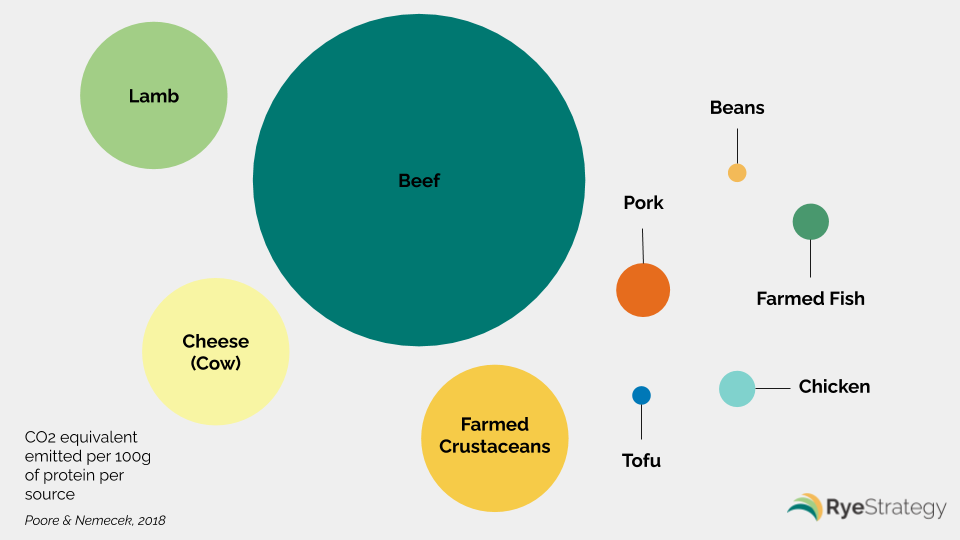The Environmental Impact of Meat Consumption
In times of quarantine and smoke, people are longing for the days they can resume large gatherings where friends, family, and colleagues can finally share a meal together. But did you know that something as simple as a meal can affect the environment? When multiplying these effects by the number of meals you’re serving or consuming, you can start to see the true cost of a meal choice.
While working with a previous client on their carbon neutrality plan, we saw how food decisions can have a considerable effect on a company’s carbon footprint. During the process of calculating their carbon emissions, we discovered that a noticeable portion of the overall footprint was arising due to the consumption of beef steaks served at an annual conference. So why is meat a culprit here? Let's dive into the environmental cost of producing and consuming meat.
The Carbon Footprint of Meat
According to the University of Michigan’s Center For Sustainable Systems, 57% of the average American’s dietary carbon footprint comes from meat consumption alone. It’s important to note that not all livestock actually emit the same amount of greenhouse gases; it varies drastically depending on the type of animal. For example, chickens produce 6.9 kg of CO2 per kg of meat, whereas beef emits 27 kg of C02 per kg produced. Below is a relative comparison of different types of proteins and their CO2 emissions.
As you can see, beef is the highest carbon emitting meat to consume. So how do cows directly affect our environment?
Cow pastures are very land-intensive due to the simple fact that they are large relative to other animals commonly eaten, such as chickens and pigs. The process of cattle ranching is a large contributor to mass deforestation.
The rate that cows develop and reproduce is slower relative to other animals grown for consumption. The average chick takes 21 days to hatch, but cows take about 280 days to give birth to a calf. This slower turnover rate of cows leads to higher usage of pastureland in order for producers to keep up with year-round beef demands.
Cows are ruminant animals, meaning the grass and plants they eat cause them to produce methane as a byproduct during digestion. Methane is a commonly cited greenhouse gas that has 21 times the global warming potential compared to carbon dioxide.
Cows are unfortunately one of the most environmentally unfriendly animals to raise and the demand for beef is rising due to consumer dietary habits and preferences, with worldwide consumption projected to increase by 70% within the next 30 years. In order to address the environmental impact of beef production globally, both consumers and agricultural corporations must take action.
Actions to Mitigate The Environmental Costs
The Global Roundtable for Sustainable Beef (GRSB) is one of the largest organizations bringing beef-producing corporations together from all around the world. The GRSB has led a successful program with New Zealand corporations to reduce greenhouse gas emissions by 30%, from implementing alternative water usage to biodiversity protection measures for their livestock practices.
Furthermore, cattle breeders around the globe have been researching how to genetically produce cows that emit less methane and carbon, and as well as exploring variations in diets to reduce their greenhouse gas production. Dr. Tara Garnett, a scientist from Oxford’s Food Climate Research Network, says that “findings offer promise, but cutting emissions from beef production can only take us so far.” As agricultural corporations work to supply beef in the most sustainable way, consumers and commercial stakeholders also have a responsibility to modify and influence their meat consumption habits.
On the individual level, switching from beef to chicken can cut one’s carbon footprint in half. On a corporate level, switching to lower emitting meats can provide even more of a substantial impact, given the numerous individuals affected by organizational decisions. If we all make an effort in reducing our meat consumption, a United Nations Climate Report estimates that global CO2 emissions could be reduced by up to eight billion tons per year, which roughly equates to 54 million acres of forest preserved.
At RyeStrategy, we strive to help organizations determine their carbon footprint so that companies can take large scale action against climate change. Even if it is a simple recommendation regarding a corporate dinner menu, we understand the impact such changes can have, and hope that you do too.
Learn about our affordable carbon footprint solutions for small and medium-sized businesses
Book a free strategy session to discuss your climate goals with a sustainability manager.
About RyeStrategy
Based in Seattle, RyeStrategy is a CDP-accredited, mission-oriented company specialized in carbon accounting, mitigation coaching, and climate disclosure solutions for organizations at any point in their sustainability journey. Learn how RyeStrategy helped Salesforce, Ideascale, and Wazoku achieve their sustainability goals.
From exhaustive carbon footprinting and mitigation coaching, to setting science-based targets and reporting climate data to CDP, SBTi or custom reporting platforms, RyeStrategy acts as a hands-on extension of the team, custom-tailoring services to fulfill climate disclosure requirements easily and accurately.
Meet with a sustainability specialist to learn more about RyeStrategy solutions.


